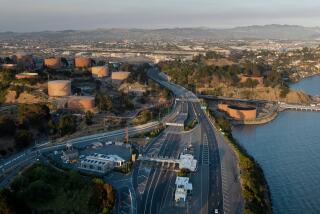Chevron is putting solar technologies to the test
- Share via
On a dirt plot near Bakersfield where a massive refinery once churned out gasoline and asphalt, one of the world’s largest oil companies is looking for something more green.
On Monday, Chevron Corp. plans to reveal that it has transformed the 8-acre site into a sprawling test facility with 7,700 solar panels. The panels, in various sizes, represent seven cutting-edge photovoltaic technologies from seven companies that Chevron is checking out as possible candidates to power its operations worldwide.
Chevron, which has operations in 100 countries, said it was looking for panels that cost less and are more reliable and efficient than what’s available today.
“We’re quite a large company that uses quite a lot of energy,” said Des King, president of Chevron Technology Ventures, a division that looks for and evaluates new technologies including those in alternative energy.
Cost savings from past energy efficiency efforts have been significant, the company said. Since 1992, when Chevron began tracking its power use and using hydrogen fuel cells and solar panels at its facilities, the company cut its energy use by nearly a third and saved nearly $3 billion, King said.
The test complex just outside Bakersfield is the latest in a move by large companies to tap emerging technologies as a way to cut energy costs.
BP Solar, a subsidiary of British oil behemoth BP, designs, manufactures and markets solar products and says it invests more than $10 million annually in photovoltaic research and development. Royal Dutch Shell has invested more than $1 billion in alternative energy projects in the past.
For its part, Chevron said it plans to spend at least $2 billion more over the next three years on renewable power ventures and research.
“All the companies are going about it in different ways,” King said of Chevron’s competitors. “Our goal is to be an early adopter.”
Chevron researchers will study how the panels perform against a benchmark system provided by Japanese firm Sharp Electronics Corp. The entire system, known as Project Brightfield, cost “millions of dollars” to develop, said Sean Connors, assistant project manager for the complex. He declined to disclose the exact cost of the venture.
The installation sits on the site of a former refinery tank yard that Chevron used from the early 1900s until 1986 and was later demolished.
Six of the solar panel companies -- Sharp, Abound Solar, Schuco, Solar Frontier Ltd., Solibro and MiaSole of Santa Clara, Calif. -- provided thin-film panels, which are known for their low manufacturing cost. Innovalight Inc., based in Sunnyvale, Calif., was the sole supplier of crystalline-silicon panels, which tend to be more expensive but are often better at converting sunlight into power.
The sloping panels will produce about 740 kilowatts of electricity that will be used to power the pumps and the pipelines operated at Chevron’s Kern River oil field facility nearby. Extra power will be transferred to the local Pacific Gas & Electric Co. utility grid under a metering system that gives Chevron credit for the excess energy.
Chevron and the other participating companies will have access to data transmitted wirelessly from the project, including reactions to different weather conditions. Chevron expects to take three years to decide which of the technologies it wants to implement at its offices and production sites.
But the company said it plans to continue using the electricity produced from the facility for 25 more years.
Chevron began planning the project in early 2008. A team scouted more than 180 companies as potential participants, scouring the Internet for information and meeting in person with executives.
After narrowing the field to the final seven firms and battling other Chevron proposals for funding, Project Brightfield sped through the local permitting process and completed construction late last year.
More to Read
Inside the business of entertainment
The Wide Shot brings you news, analysis and insights on everything from streaming wars to production — and what it all means for the future.
You may occasionally receive promotional content from the Los Angeles Times.











